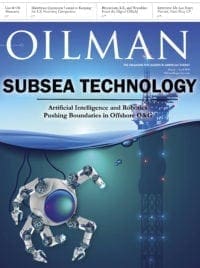Digital innovation strategies incorporating the Industrial Internet of Things (IIoT) are top-of-mind for oil and gas operators working to achieve greater productivity and lower costs, even in the face of escalating prices. While the use of connected equipment to help improve operational visibility and control isn’t new, advances in software and analytics capacity give operators an entirely new asset for business improvement: data.
The enormous amounts of data generated by connected equipment can provide incredible insight and awareness into a machine’s health, operating condition, and performance. By using detailed asset specifications, real-time data, and contextual information such as environmental conditions, a well-designed IIoT system creates a digital model of each piece of equipment and then uses powerful analytics, machine learning, and rules-based automation to enable a variety of beneficial operational capabilities.
Examples include predicting potential equipment failures or safety hazards; diagnosing problems and prescribing required repair steps for service technicians; and comparing and optimizing equipment performance and efficiency across an entire population of assets. These functionalities lead to increased output, lower repair costs, and optimized productivity and safety across an entire O&G business, from upstream to downstream.
Yet this same treasure trove of data often proves overwhelming when companies attempt to make sense out of it. As more equipment comes outfitted with sensors and contributes more data to the deluge, how can O&G companies extract the business value buried in the data?
IIoT – A Maturity Progression
Adopting IIoT is not a one-time effort. It is a progressive process that starts with connected equipment and can evolve to the point of nearly autonomous machinery able to perform sophisticated analytics and take action even in the absence of network connectivity. Here’s what you need to know about getting started:
First, identify the business objectives you wish to achieve, such as predictive maintenance, to help anticipate failures and pinpoint the root cause.
Second, identify the team required to realize your objective. All IIoT initiatives demand cooperation throughout multiple departments. While details can vary, key stakeholders generally range from IT and trusted business partners to subject matter experts and operations personnel such as engineers, technicians, and reliability professionals that work with the equipment on a regular basis.
Finally, review the following stages of IIoT maturity, as well as internal operational and technology capabilities, with your team to determine the current state of your organization and what steps are necessary to progress to the level needed to achieve your desired business goals.
Stage 1: Device Connectivity and Data Forwarding – Nowadays, more and more machinery comes equipped with sensors to help operators gain insight into the equipment’s operation and health. And while it is a foundational first step, simply connecting equipment and collecting data doesn’t produce real organizational benefit until that data is monitored and analyzed.
Stage 2: Real-Time Monitoring – Equipment data can be used to populate real-time dashboards that allow personnel to view asset telemetry and provide alerts when conditions meet predetermined benchmarks that can indicate a possible failure or trouble on the horizon. This provides greater visibility from a centralized location and some level of condition-based insight. However, relying heavily on a human element to analyze and interpret mountains of operational data can invite unacceptably high levels of false positives. Likewise, the system’s capacity to scale is severely limited because, as more connected equipment comes on line, large amounts of useful data is often discarded to make it possible for human operators to evaluate results.
Stage 3: Data Analytics – Analytics provide the power to look deeply into intricate machinery that can have complex problems. A successful data analytics system requires several components: data discovery, machine learning, cluster analysis, and digital modeling. With these elements in place, powerful analytics can examine much larger and more complete data sets in conjunction with external data sources such as environmental conditions. The result is a more accurate evaluation of a machine’s state and probability of failure. These insights enable a more effective use of technician time, and make it possible to identify the exact parts, expertise, and steps needed to perform repairs to deliver high first-time fix rates. Predictive analytics can also help extend the useful life of expensive assets by establishing preventative maintenance plans based on when service is actually needed, rather than based on fixed time or use intervals.
Stage 4: Automation – Creating rules with the help of subject matter experts, and applying automation, enables the orchestration of complex actions—such as placing work and parts orders, scheduling the closest qualified technician, and estimating time to repair. Rules can be modified to respond to a machine’s health; for example, if everything is running smoothly, less data is collected and transmitted, but if the system detects a change in the machine’s state, it can increase collection rates to provide more detail. Rules can also be created to monitor real-time operating parameter status and automatically optimize equipment performance or shut it down in the event of a threat to safety. Over time, as more data is collected and rules are applied and refined, the system becomes increasingly intelligent and is able to perform a greater scope of automation.
Stage 5: Enhancing On-Board Intelligence – The final stage of IIoT maturity is to perform the bulk of data collection and analytics on or near the asset. Today’s connected equipment often already has computing capabilities that can be tapped for this purpose. By employing this type of edge or distributed computing, companies save on network transmission and data storage costs, and automated actions take place even in the absence of network connectivity—for example, stopping a machine if it poses a safety hazard. Without network and storage considerations, 100% of the data can be analyzed and applied to yield faster and more accurate results.
Putting IIoT to Work for You
Depending on where your organization falls along the maturity progression, IIoT can extract business value from your existing operational data, whether providing insight into the health of a handful of machines or optimizing the performance of your entire asset population. Advances in IIoT software make it possible to achieve what was previously an expensive and manpower-intensive endeavor. By identifying your goals, ensuring management support and cross-team collaboration, and progressing through the stages of IIoT maturity, your organization can expect to see measurable benefits.






